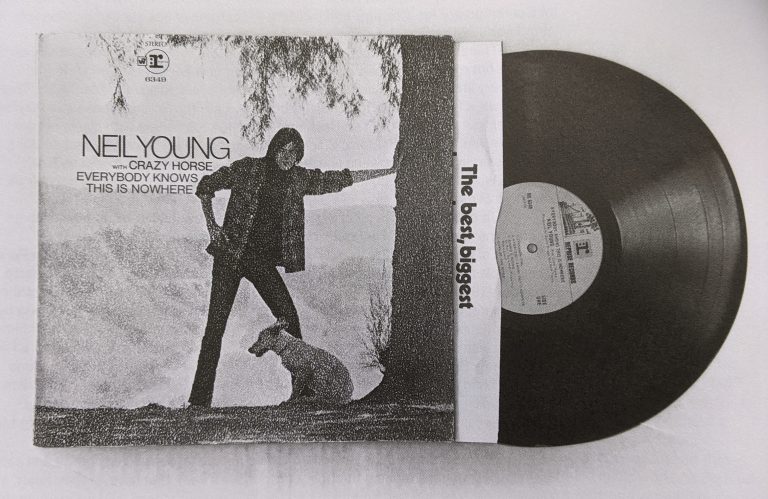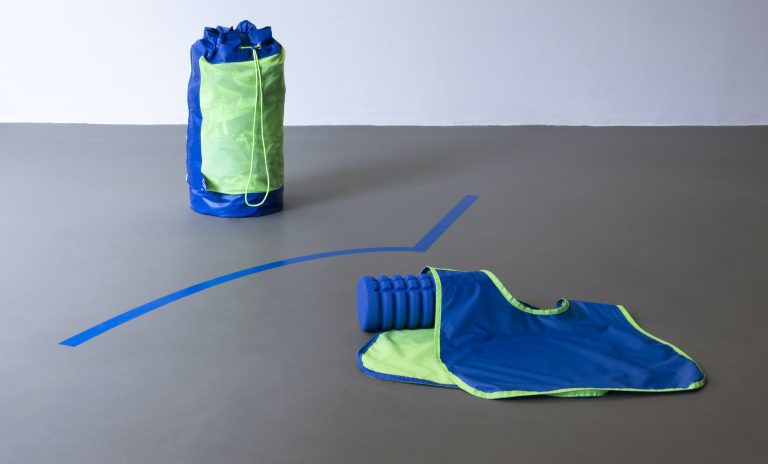Watching GLUE (2017) feels like stepping into five years of friendship between Irish artists Oisin Byrne and Gary Farrelly; conversations, games, wit, coercions, jokes, monologues, identities unravel on the screen in an intimate portrayal of creative co-authorship. Confluence is the engine that sets Byrne’s and Farrelly’s work in motion, both in their joint practice and in their chosen narratives; it’s threaded through all of their constructions, and the rippling out of unlikely connections continues long after one’s initial encounter with their work. Byrne’s practice is steeped in literature and theory, without being deformed by them, while Farrelly’s is grounded in bureaucracy, correspondence, and performance. Their conjoined practice plays dynamically with linguistic forms, using their shared projects as a reason to talk, meet, and make.
GLUE is almost feature-length, at fifty minutes; this is also, inadvertently (to Byrne’s delight), the length of a psychoanalytic session. Through a plethora of constructed identities performed by Farrelly, we are presented with a gender queer narcoleptic who refuses a unitary self. Punctuated with intervals of sleeping, Farrelly’s various characters unfold through monologue (sometimes diatribe) and conversation with friends. The setting moves across countries from interior domestic sites – the sitting room, dinner table, bed, or bath – to public spaces, like a park bench, ‘the floating train’ in Wuppertal, or the exteriors of sometimes grand dilapidated buildings. While the narrative seems to be grounded in Gary’s pregnant friend’s swelling belly (and what that might mean for Gary), ideas and emotions move the film forward. It took five years to make and progressed into a stand-alone film, originally part of a larger series of outcomes and conversations. Directed by Byrne and exclusively edited by him, each artist is responsible for different parts of the making. With Farrelly as the main performer, Byrne used a mode of ‘game-play’ to set up a series of coercive strategies that force Farrelly into action and dialogue, almost teasing the fragmented characters to come to the surface. Farrelly as a performer is ‘fugitive’ in this sense.
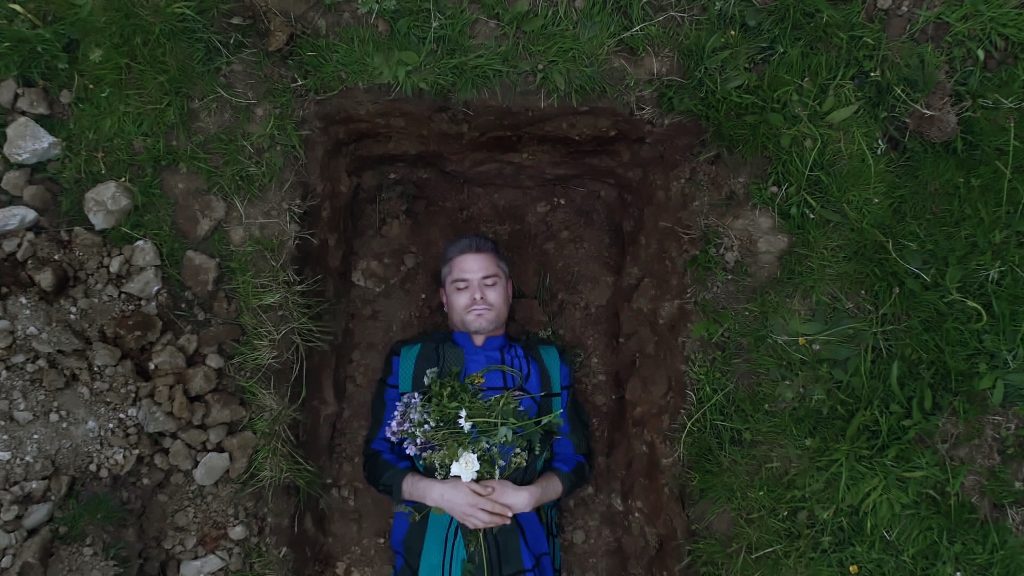
Oisin Byrne feat. Gary Farrelly
Still from GLUE, 2017
Courtesy of the artist
The film initially stemmed from a mutual interest in name-calling. In the opening scenes, we are witness to an onslaught of comical and incongruous insults thrown between Farrelly and his many selves. ‘Hi sad sad soul… Hi vice presidential candidate…Hi badly built road…’ In conversation, Farrelly tells me, ‘once you go past your material, and you’re thinking in real time, invariably you are producing the insults that if you were someone else you would give to yourself.’ He remembers ‘Sledgehammer Dentist’ as a particularly potent insult, belittling someone’s dentistry being one of ‘the most devastating things you could say because not only are you insulting their physicality and their genetic makeup but also their economic position in the world’. At one point in the film, Farrelly’s character expresses his desire to host the Eurovision song contest but can’t because he ‘doesn’t have the teeth for it. The narcolepsy drugs ground them all off.’
Byrne has previously written about the emotional elements and theoretical underpinnings of name-calling in his essay ‘On Being Named’, which appeared in E.R.O.S. Issue VIII: Self/Love. In this essay he reflects on when he was first called ‘gay’ as a boy and simultaneously quotes a scene from John Water’s Mondo Trasho (1969), within which, two older ladies pass comment on another woman. ‘The litany of insults is so extensive and various that their indiscriminate (and somewhat desperate) disgust is made absurd.’ In GLUE, we see Farrelly and Byrne reclaim the agency of name-calling, as Barthes put it, ‘[w]hat I can name cannot really prick me. The incapacity to name is a good system of disturbance.’ [1]
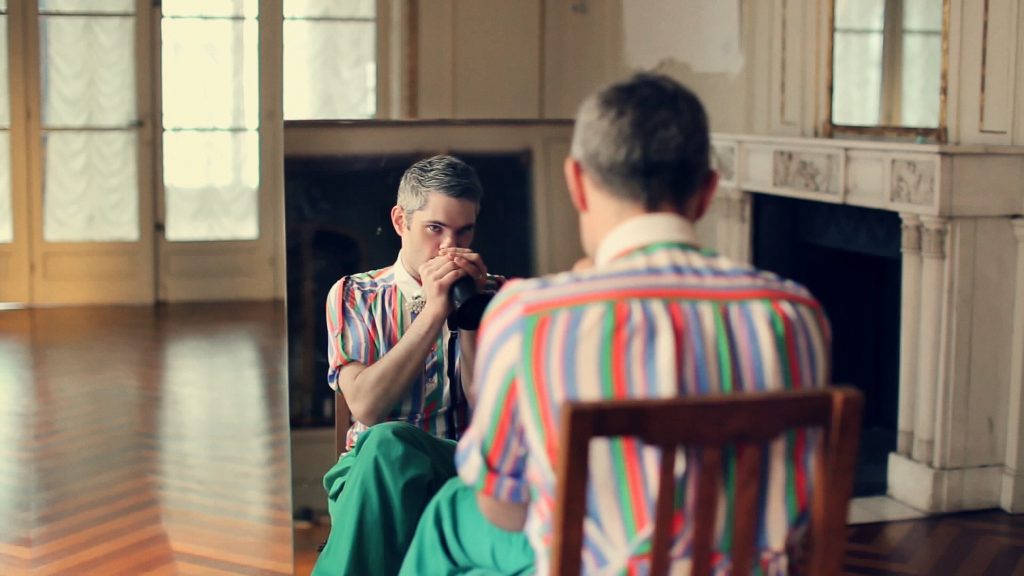
Oisin Byrne feat. Gary Farrelly
Still from GLUE, 2017
Courtesy of the artist
Both Farrelly and Byrne claim that they have become particularly performative in the way they interact. Byrne calls GLUE a ‘permissive’ autofiction. The playful insults are how they answer the phone to each other, in ’tortured housewife accents’, a demonstration of how the real seep into such projects. They also correspond, sending one another photographs, lists, even pieces of wood. Farrelly is particularly interested in posting things you think you shouldn’t. Living in Brussels while Byrne is in London, they interact primarily through projects and making work. Their practice is the site where they (and their interests in language, categorisation, certain kinds of camp and performative selves) encounter each other in a joint enterprise.
GLUE speaks to the inescapability of being perceived as one thing – gay, artist, single, married. Whatever it is, we are validated or haunted by such denominations. The viewer is guided through this existential doubt by Farrelly’s voice ventriloquising the concerns of the societal, familial, and relationship pressures he feels. Yet, Farrelly’s character is wilfully liberated in his refusal to live in a particular way. In Sheila Heti’s How Should a Person Be? (2010), a book written in the painting studio of a close friend of the author, certain ways of being are similarly exposed and explored. Real-life conversations and emails between Heti and her friend Margaux Williamson bleed into the work. In an in-conversation at the Birkbeck Institute, Heti stated she wanted to write about Williamson and their friendship as a primary relationship as opposed to secondary or tertiary. Similarly, Byrne and Farrely use their friendship as a host to play with syntax and discussion within their shared research interests and concerns.
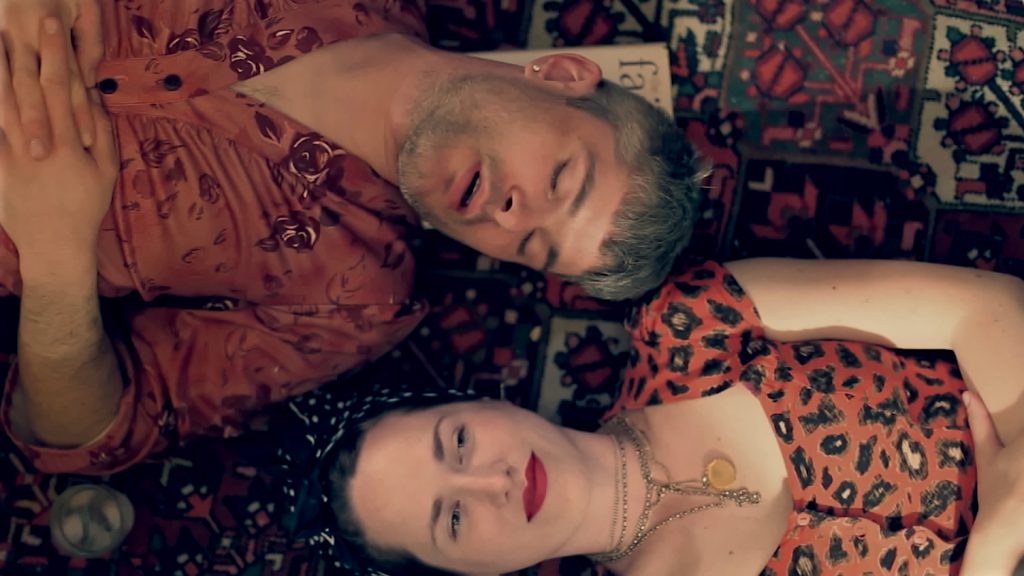
Oisin Byrne feat. Gary Farrelly
Still from GLUE, 2017
Courtesy of the artist
As a chapter in a longstanding collaboration, GLUE is underpinned by a rejection of the idea of a settled notion of the self, within the constant operating system of doubt engendered by the current cultural moment. Farrelly reflects that ‘[e]veryone is a federation of opinions, memes, constantly oscillating political allegiances and there’s a constantly reconstituted constellation of opinions.’ These ideas segue into each artist’s individual practice.
Byrne’s practice is grounded in identity, gender, intimacy, and literature. Within the meta narrative of GLUE, he has the ability to tease out emotions through the work, using them as tools to drive things on. Having always been interested in language and its uses, he is currently exploring the possibilities of the sung voice; the soundtrack of GLUE features Byrne singing with Nina Hynes. At the moment, he is producing ‘sardonic pop songs’ in collaboration with Adam Gibbons, with whom Byrne studied at Goldsmiths. As he explains, in all of his work there is a lot of surplus. ‘With GLUE, there is so much left on the cutting room floor; there are paragraphs I still want to take care of. Songwriting for me is a way of using the surplus from my writing. So all of the orphan sentences from my essays get sellotaped together and made into these weird theory songs.’ [2]
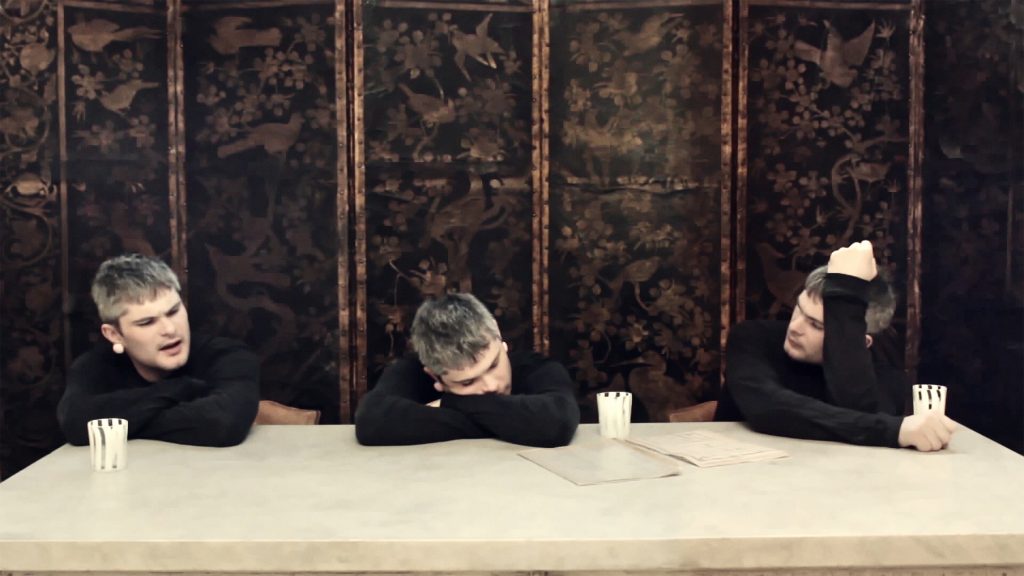
Oisin Byrne feat. Gary Farrelly
Still from GLUE, 2017
Courtesy of the artist
He is interested in questions such as: ‘how far can you push a song?’ Stretching language to its extremes, he draws from writers like Joyce who dissected language, considering how a word can be undone, cut up or ‘fucked with’. Byrne considers how a word inhabits a space in different forms, as an object in a text or as a sound in a spoken sentence or sung- somatic or bodily sounds like a groan. How does the meaning of language alter when it changes from speech to song? As Irish writer Jamie O’ Neill has observed: ‘In Ireland we have a playfulness with our English. The language is not a national treasure. It’s a borrowed thing, a loaned vocabulary on an older Gaelic syntax. Picture it and you see peasants cavorting in the Big House, chopping up the Chippendale for low use on the fire.’ [3] Byrne is interested in this ‘proper improperness’ that enables a kind of productive disrespect or misuse of the language. This recycling and harvesting of words is seen in GLUE in some of the insults proclaimed from Farrelly (Hi Modernity… Hi Canadian Tourist…..). When I saw the film at Goldsmiths Centre for Contemporary Art in London, it was this ‘Irishness’ that drew me to it.
Farrelly is also interested in the Irish rhythms of speech; the elastic use of language informs his own work: ‘All the intonations are reversed. There’s a huge emphasis on the emotional impact of sentences that the English don’t really have. You see that in our writers and playwrights and in music as well – a strange inhabitation of language. At the same time, there’s a desire to subvert it and sabotage how sentences work. How much can you sabotage a sentence for it still to read in the public space?’ [4] GLUE is Inherently Irish in its use of language though it was filmed across many different countries. Its exhibition trajectory has also been international. It was first screened in Austria where perhaps the linguistic gymnastics might be lost in translation, then in London to an English audience where the linguistic tropes might be missed. It was exhibited in September this year at Lismore Castle Arts in Ireland.
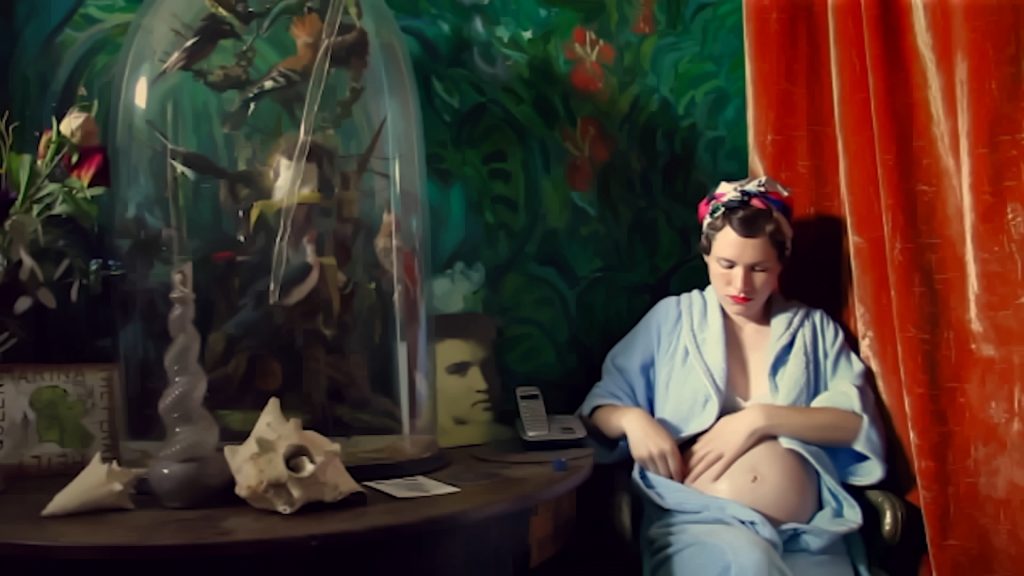
Oisin Byrne feat. Gary Farrelly
Still from GLUE, 2017
Courtesy of the artist
Farrelly has more bureaucratic concerns in his own practice. Byrne’s and Farrelly’s work is not quite as explicitly codified in its jointness as Farrelly’s work with Chris Dreier, which is an ‘institution’. Together himself and Dreier founded the Office for Joint Administrative Intelligence (OJAI), a self-institutionalised multi-modal practice that concerns itself with power structures embedded in architecture and the agency of the self in history’s bigger narrative, among other things. They think about architecture not under ecology and economics but under four pillars – violence, control, panic and pleasure. ‘I think that architecture is something that everybody has done to them. Contemporary art, literature, theatre or sport are all things that you could more or less avoid. But you’re digested by buildings every single day.’
OJAI have their own thirty-minute monthly radio show on KUZU 92.9 FM which airs in Dallas, Texas, which can be listened to in the archive of pre-recorded shows on their website. In October 2019, they also organised a conference addressing practices that self-institutionalise as an artistic strategy: The European Conference of Institutional Ideators at Groelle Pass Projects in Wuppertal, Germany. The conference explored practices that appropriate institutional identities, processes and language as tools for research, performance, and production. In doing so, it addressed questions related to the motivation, methodology, and critical efficacy of bureaucratising an artistic practice.
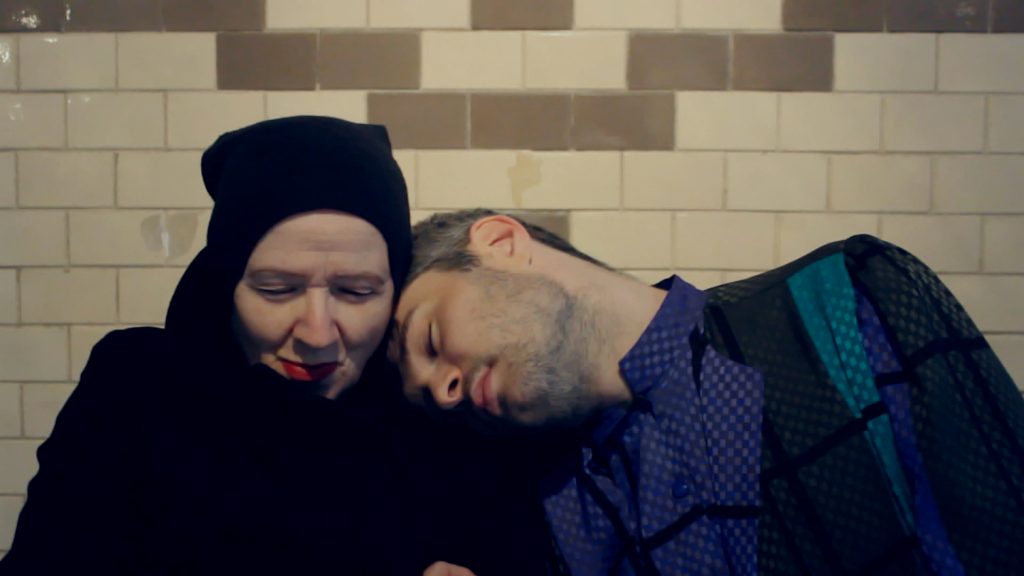
Oisin Byrne feat. Gary Farrelly
Still from GLUE, 2017
Courtesy of the artist
Collaboration, in this sense, is the bedrock of Byrne and Farrelly’s individual practices. It persists through their endeavours in conflating, cementing, gelling, generating and producing work, not only with each other but in most aspects of their working lives. GLUE has an enduring quality that makes the case for anchoring friendship in a practice as a generative host. There are always relationships around the making of a work of art; conversations, conflicts, tensions, heartbreaks, disappointments, ameliorations. Trust is necessary for such co-authored projects to be fruitful. As Farrelly trusted Byrne to make all decisions in the edit of the film, Byrne trusted Farrelly to perform while filming. And with parallel careers, competitiveness is necessary to propel the work forward. As a practice in itself, friendship here seems like a model. Adam Gibbons, Byrne’s musical collaborator, describes GLUE as having ‘an enviable intimacy of production’. Together they have managed to insert a tiny wedge between the name and the named, found a crack in the wall built of habit and certainty, and worked into that small fissure a measure of existential rebellion.
Notes
[1] Roland Barthes, Camera Lucida: Reflections on Photography, transl. Richard Howard (New York: Hill and Wang, 1981), 51.
[2] Conversation with the artist, 12 June 2019.
[3] Jamie O’Neill, ‘Whims and Shams, Puns and Flans’, The Guardian, 22 November 2003.
[4] Phone conversation with the artist, 26 July 2019.
Gwen Burlington is an Irish writer based in London.


